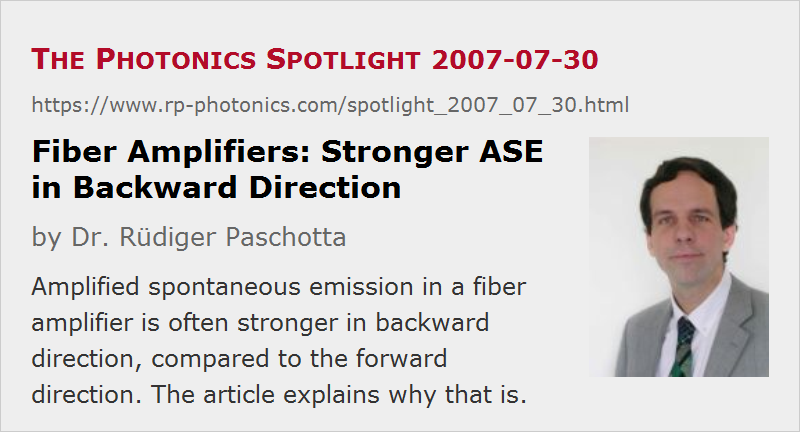Fiber Amplifiers: Stronger ASE in Backward Direction
Posted on 2007-07-30 as a part of the Photonics Spotlight (available as e-mail newsletter!)
Permanent link: https://www.rp-photonics.com/spotlight_2007_07_30.html
Author: Dr. Rüdiger Paschotta, RP Photonics Consulting GmbH
Abstract: Amplified spontaneous emission in a fiber amplifier is often stronger in backward direction, compared to the forward direction. The article explains why that is.

Ref.: encyclopedia articles on amplified spontaneous emission and fiber amplifiers
It is often found that the power carried away by amplified spontaneous emission (ASE) in a fiber amplifier is substantially (often several times) larger for the backward direction (i.e., the direction opposite to that of the pump light) than for the forward direction. This may seem surprising, as the gain (amplification factor) is of course the same for both directions: we are not dealing with a non-reciprocal device.
To clarify this issue, we can begin with locating the asymmetry which is behind the asymmetry of ASE powers. It is of course not the pump propagation direction as such – how should that matter? – but rather the higher excitation density on the side from where the pump light comes.
Now consider the simple example of two subsequent pieces of rare-earth-doped fiber, where the dopant ions (e.g. Er3+) have a quasi-three-level system. The first piece of fiber is strongly pumped so as to exhibit positive net gain, while the second piece is only weakly pumped so that it just reaches the transparency level, i.e., zero net gain. Now see what happens to the ASE:
- Consider first the forward direction, with ASE coming from the first fiber and then going into the second one. As the second fiber has no net gain, it will only weakly increase the ASE power by adding some spontaneous emission.
- For the backward direction, the situation is different: the weakly pumped fiber provides some level of spontaneous emission, which acts as a seed for the more strongly pumped fiber. Here, the contribution of spontaneous emission in the weakly pumped fiber is stronger, since it has to be compared with the weak ASE at the input end, rather than the strong ASE at the output end of the strongly pumped fiber.
In a real fiber amplifier, we of course have a gradual decrease of excitation density, but this will obviously not change the situation altogether.
Even for a four-level fiber amplifier, based e.g. on neodymium, there could be somewhat stronger ASE in backward direction, if the fiber has significant parasitic losses: backward ASE has to travel a shorter distance before being detected. Such effects, however, are usually much less pronounced than the above mentioned ones in quasi-three-level amplifiers.
This issue alone would suggest that backward pumping is always preferable, and that would be underlined by the remark that the power efficiency (even without ASE) is often better that way (for other reasons). However, the noise figure is usually lower for forward propagation. A good compromise (if that is required) may be bidirectional pumping.
This article is a posting of the Photonics Spotlight, authored by Dr. Rüdiger Paschotta. You may link to this page and cite it, because its location is permanent. See also the RP Photonics Encyclopedia.
Note that you can also receive the articles in the form of a newsletter or with an RSS feed.
Questions and Comments from Users
Here you can submit questions and comments. As far as they get accepted by the author, they will appear above this paragraph together with the author’s answer. The author will decide on acceptance based on certain criteria. Essentially, the issue must be of sufficiently broad interest.
Please do not enter personal data here; we would otherwise delete it soon. (See also our privacy declaration.) If you wish to receive personal feedback or consultancy from the author, please contact him e.g. via e-mail.
By submitting the information, you give your consent to the potential publication of your inputs on our website according to our rules. (If you later retract your consent, we will delete those inputs.) As your inputs are first reviewed by the author, they may be published with some delay.
 |



If you like this page, please share the link with your friends and colleagues, e.g. via social media:
These sharing buttons are implemented in a privacy-friendly way!